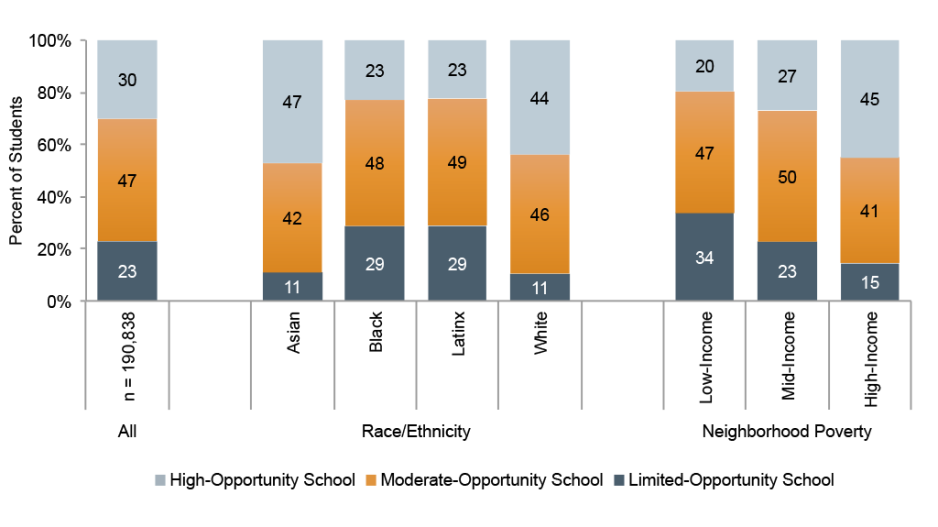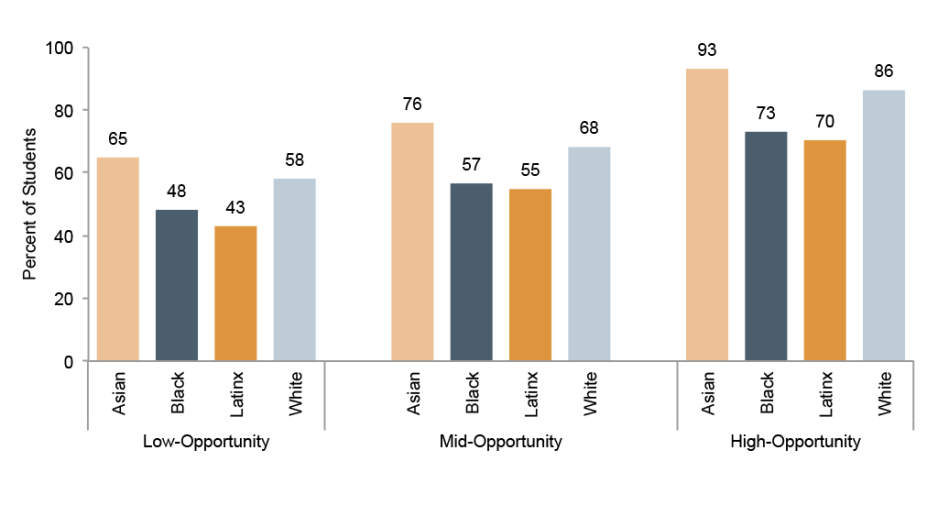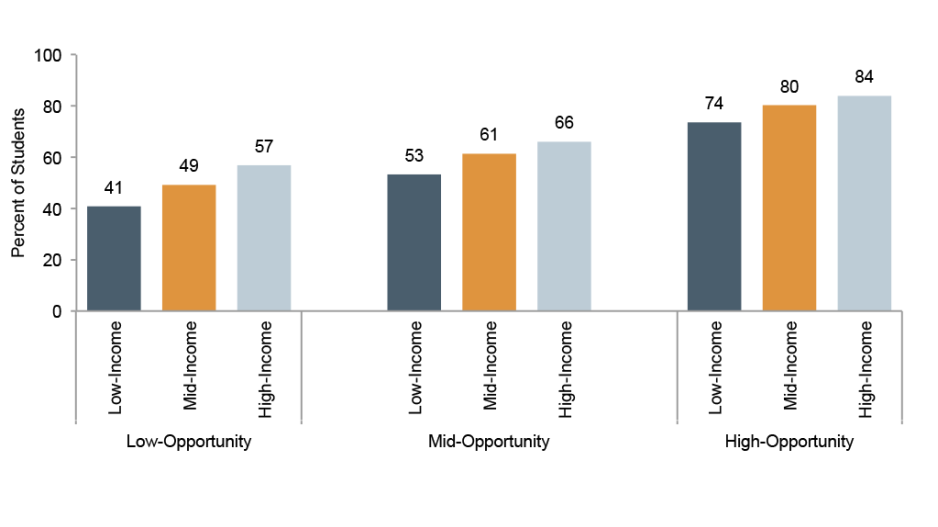This post is the second in a regular series exploring indicators of equity in NYC schools as part of the COVID-19 and Equity in Education Project which is supported by the Bill & Melinda Gates Foundation and the AIR Equity Initiative.
As a part of our ongoing series examining indicators of education equity in New York City, this post focuses on access to advanced coursework in high school, which past research has found to be linked to academic engagement, as well as preparation for college[i]. Information about disparities in access to advanced courses can provide educators and policymakers with actionable insight into students’ experiences in high school and the conditions that either widen or curtail gaps in key student outcomes.[ii]
Below, we examine the degree to which students in NYC have had opportunities to take classes that would help them graduate from high school and prepare for post-secondary education. Focusing on students who entered 9th grade between 2013 and 2015,[iii] we explore how access to advanced coursework varies by race/ethnicity and neighborhood poverty. We do this by examining two different kinds of inequitable access to advanced coursework:
- Differences across high schools in the availability of advanced courses. Students may attend high schools that differ in the availability of advanced courses due to the ways that students and families navigate the school choice process or the ways that schools select students based on prior performance.
- Differences in the kinds of classes students take once they are in high school. These differences might be shaped by tracking practices or by students’ prior preparation, including opportunities to take advanced coursework in middle school.
How equitable is student access to advanced coursework in high school?
To assess students’ access to rigorous coursework, we grouped the high schools in our sample into three categories based on the number of advanced courses they offered relative to their size: high-opportunity schools, moderate-opportunity schools, and limited-opportunity schools.[iv] For this analysis, we considered any Advanced Placement (AP), International Baccalaureate (IB), dual enrollment course, or course designated as “advanced,” “honors,” or “accelerated” to be advanced. (For more information about our sample, subgroup definitions, distributions of students into schools, and alternative versions of the indicators, please see the working technical appendix on the project page.)
We then examined whether enrollment in the three categories of high schools differed by race/ethnicity and neighborhood poverty.[v] As shown in Figure 1, about 29 percent of Black and Latinx students attended limited-opportunity schools, compared with only 11 percent of Asian and White students. Conversely, high-opportunity schools served only 23 percent of Black and Latinx students but 47 percent of Asian students and 44 percent of white students. In other words, Black and Latinx students were disproportionately enrolled in the high schools with the fewest opportunities to take advanced courses, while White and Asian students were disproportionately enrolled in the highest-opportunity schools.
A similar pattern appeared for differences in access to advanced coursework by neighborhood poverty. We found that 34 percent of the students residing in the lowest-income neighborhoods were enrolled in limited-opportunity schools, compared with just 15 percent of those in the highest-income neighborhoods. Students in these high-income neighborhoods were substantially more likely than other students to attend a high-opportunity school.
Schools with moderate opportunities to take advanced courses tended to serve more equal proportions of students by race/ethnicity and socioeconomic background—between 40 and 50 percent of each group.
Figure 1: Enrollment into High-, Moderate-, and Limited-Opportunity Schools by Race/Ethnicity and Neighborhood Poverty

How equitable is advanced coursetaking within high-, moderate-, and limited-opportunity schools?
When we examined actual rates of advanced coursetaking within each of these categories of schools,[vi] we found two dominant patterns. First, all students enrolled in high-opportunity high schools were far more likely to take an advanced course than their counterparts in limited-opportunity schools. This was especially true for Black and Latinx students and students from the lowest income neighborhoods. These underrepresented students were approximately 30 percentage points more likely to take an advanced course if they were enrolled in a high-opportunity school than a limited-opportunity school. In fact, underrepresented students in the highest-opportunity schools were generally more likely to take advanced courses than their more advantaged peers in low- and moderate-opportunity schools. Please see the working technical appendix on the project page.
The second prominent pattern we observe is that, even when Black and Latinx students and students from low income neighborhoods enrolled in high-opportunity schools, they were much less likely to take advanced courses than their white, Asian, and higher-income peers in the same schools. As a result, these students are both significantly underrepresented in high-opportunity schools and are disproportionately left out of the many advanced courses that are offered in those schools.
It is important to note, however, that advanced course-taking disparities within each of the opportunity categories operated in slightly different ways for each student subgroup. For Black students, the gap in advanced coursetaking vis-à-vis Asian and White students was strikingly similar across opportunity categories—with Black students taking advanced courses about 75 percent as often as Asian students and about 83 percent as often as White students in similar schools. For Latinx students, on the other hand, gaps in advanced coursetaking were substantially larger in the lowest-opportunity schools than in the highest-opportunity schools. Likewise, gaps between students from the lowest- and highest-income neighborhoods were much larger in limited-opportunity schools than in high-opportunity schools.
Figure 2: Percentage of Students Taking at Least One Advanced Course by the End of Grade 12, by Race/Ethnicity and School Opportunity Level

Figure 3: Percentage of Students Taking at Least One Advanced Course by the End of Grade 12, by Neighborhood Poverty and School Opportunity Level

For underrepresented students, then, the challenge in accessing advanced coursework is both a function of the schools they attend and their opportunities to take advanced courses once there. Black and Latinx students, and students from less advantaged neighborhoods, have a much better chance of taking advanced courses if they attend one of the schools that offer more of these courses—but they are still much less likely to do so relative to more advantaged students in similar schools.
These findings suggest that we should be doing more to make a wide variety of advanced courses available in high schools throughout the City, but particularly in those schools that serve large numbers of Black and Latinx students and students from low-income neighborhoods. These results also suggest that in order to improve equity in coursetaking, we will need to reduce barriers to coursetaking that underrepresented students in all schools face. We will begin to explore some of the additional issues surrounding students’ access to rigorous coursework in our next post in the series.
Big Questions
- How should our measure of “access to advanced coursework” be refined? Are there other aspects of course rigor and quality that we should consider? We examine some alternatives to our particular definition of advanced coursetaking in the technical appendix, but our initial approaches have all focused on the number of advanced classes offered given the size of the school, without considering the quality or composition of the classes, the breadth of the curriculum, or the experience level of the teachers. We are continuing to think about how these additional dimensions course rigor and quality might be captured.
- To what extent are disparities in access to advanced courses a function of disparities in students’ prior academic engagement and performance in middle school? Are there middle schools that are doing a better job sending underrepresented students to high schools where they will have more opportunities to take advanced courses? Similarly, are there middle schools that are doing a better job preparing underrepresented students to take competitive classes once in high school?
- How has access to advanced coursework changed over time? As part of the AP for All initiative, which launched in 2015, the NYC Department of Education has been working to expand access to AP courses for students across the City, particularly in smaller high schools (which, even with the adjustments for size, are disproportionately clustered in our limited-opportunity category). To what extent do we see changes in access and coursetaking in the years following this analysis as a result of this initiative?
- How has the Covid-19 pandemic affected students’ access to advanced coursework? Changes in enrollment, staffing, and resources over the last two years may all have produced dramatic shifts in the way that students access advanced coursework in their schools.
- How does access to advanced coursework differ by other student characteristics? This post examines differences in access for students by race/ethnicity and neighborhood poverty, but it will also be important to look at disparities for other historically underrepresented groups, such as students classified as English learners and students with disabilities.
This post was authored by Kristin Black and Kathryn Hill.
Endnotes
[i] See, for example: Attewell, P., & Domina, T. (2008). “Raising the Bar: Curricular Intensity and Academic Performance.” Educational Evaluation and Policy Analysis, 30, 51–71. Also Long, M. C., Conger, D., & Iatarola, P. (2012). “Effects of High School Course-Taking on Secondary and Postsecondary Success.” American Educational Research Journal, 49, 285–322
[ii] See Conger, D., Long, M. C, & Iatarola, P. (2009). “Explaining Race, Poverty and Gender Differences in Advanced Course Takings.” Journal of Policy Analysis and Management, 28, 555-576. For a discussion of these issues with respect to English learners, see: Callahan, R. M., & Shifrer, D. (2016). “Equitable Access for Secondary English Learner Students: Course Taking as Evidence of EL Program Effectiveness.” Educational Administration Quarterly, 52(3), 463-496.
[iii] In line with the NYC Department of Education’s practice when reporting outcomes, students who eventually transfer out of the district are removed from the sample. Students who drop out remain in the denominator for all outcomes calculations.
[iv] The measure of advanced coursework opportunity is based on the ratio of the number of advanced courses offered to the number of students for each school. This measure divides the number of semesters of advanced courses offered in a high school in any given year by the total number of enrolled students, which adjusts for the fact that larger high schools will naturally offer a higher number of advanced courses than smaller schools. Read more in the project's working technical appendix.
Based on these measures, approximately 30 percent of students citywide were enrolled in high-opportunity schools -- those offering more than 17 AP, IB, dual enrollment, or honors/advanced courses per 100 students. Another 47 percent of students were enrolled in schools with moderate opportunities for advanced coursetaking -- those offering between 4 and 16 of these courses per 100 students. Approximately 23 percent of students were enrolled in schools with few opportunities for advanced coursetaking—those offering 3 or fewer of these courses per 100 students.
There are differences in the number of advanced courses by year. The statistics reported in this post refer to the 2016 course offerings. Find additional information about the changes in these measures over time, as well as the cutpoints for each of the categories, in the project’s working technical appendix.
[v] Our socioeconomic status markers are based on the median household income in students’ neighborhoods of residence in 9th grade. Students in the lowest quartile of neighborhoods by this measure are considered to be “low income,” while students in the highest quartile are considered to be “high income.” The medium income category includes the 50% of students in the middle of the distribution based on neighborhood income.
[vi] Subgroup averages in advanced coursetaking are calculated within school opportunity level, which means that averages are reflective of differences in enrollment across schools within each category.
Figure Notes
Source: Research Alliance calculations based on data obtained from the NYC Department of Education.
Notes: Total student n = 190,838. Low-Income n = 42,541; Mid-Income n = 97,326; High-Income n = 50,971; Asian n = 33,887; Black n = 51,436; Latinx n = 75,204; White n = 26,803. Data drawn from 499 high schools serving grades 9-12 or 6-12 between 2014 and 2016. District 75, 79, 88, and 84 (charter) schools are not included due to limited course data. For additional information about the subgroups in this post, please see the technical appendix.
How to Cite this Spotlight
Black, K., Hill, K. 2022. "Access to Advanced Coursework in NYC High Schools." Spotlight on NYC Schools. Research Alliance for New York City Schools.

